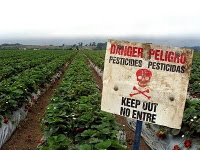Over the past decade or so, we have seen a growing popularity of farmers markets pop up in major cities and our local communities. Maybe you have visited one of these yourself. If you have, maybe you’ve noticed the crowds and busy checkout lines. Well – there is good reason that the lines are crowded and maybe you should make the extra trip and join the wait.
Pesticides are in almost everything we eat grown from the ground found in our grocery stores. Pesticides are defined as substances or mixtures of substances intended for preventing, destroying, repelling or mitigating any pest. A pesticide may be a chemical, biological agent (such as a virus or bacterium), antimicrobial, disinfectant or device used against any pest. Pests include insects, plant pathogens, weeds, molluscs, birds, mammals, fish, nematodes (roundworms), and microbes that destroy property, spread disease or are vectors for disease or cause nuisance. Although there are benefits to the use of pesticides, some also have drawbacks, such as potential toxicity to humans and other animals. According to the Stockholm Convention on Persistent Organic Pollutants, 9 of the 12 most dangerous and persistent organic chemicals are pesticides.
Why Should You Care About Pesticides? There is growing consensus in the scientific community that small doses of pesticides and other chemicals can adversely affect people, especially during vulnerable periods of fetal development and childhood when exposures can have long lasting effects. Because the toxic effects of pesticides are worrisome and not well understood, shoppers are wise to minimize exposure to pesticides whenever possible.
What’s the Difference? An EWG(Environmental Working Group) simulation of thousands of consumers eating high and low pesticide diets shows that people can lower their pesticide exposure by almost 90 percent by avoiding the top twelve most contaminated fruits and vegetables and eating the least contaminated instead. Eating the 12 most contaminated fruits and vegetables will expose a person to about 14 pesticides per day, on average. Eating the 12 least contaminated will expose a person to less than 2 pesticides per day. Less dramatic comparisons will produce less dramatic reductions, but without doubt using the Guide provides people with a way to make choices that lower pesticide exposure in the diet.
What are the 12 most contaminated types of produce?
- Peaches
- Strawberries
- Apples
- Spinach
- Nectarines
- Celery
- Pears
- Cherries
- Potatoes
- Bell Peppers
- Red Raspberries
- Imported Grapes
What are the 12 least contaminated types of produce?
- Onions
- Avocados
- Frozen sweet corn
- Pineapples
- Mangos
- Asparagus
- Frozen sweet peas
- Kiwi
- Bananas
- Cabbage
- Broccoli
- Papaya
Many of these items may be in your refrigerator right now. The question arises – How can I reduce the amount of pesticides in put in my body? While washing and rinsing fresh produce may reduce levels of some pesticides, it does not eliminate them. Peeling also reduces exposures, but valuable nutrients often go down the drain with the peel. The best option is to eat a varied diet, wash all produce, and choose organic when possible to reduce exposure to potentially harmful chemicals.
Although many grocery stores are now carrying organic products, a farmers market is a sure bet. Next time you drive by a busy local farmers market you may reconsider stopping by!

